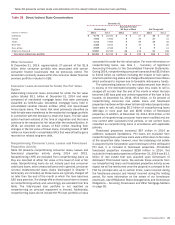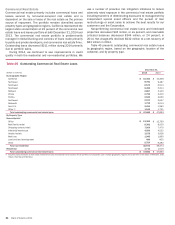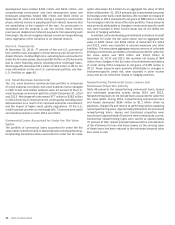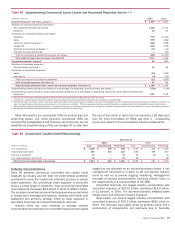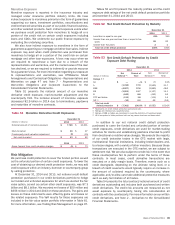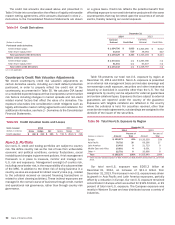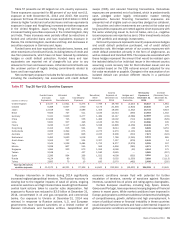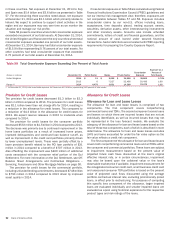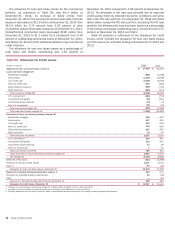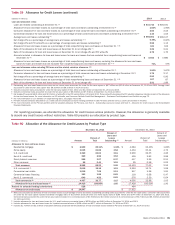Bank of America 2014 Annual Report Download - page 89
Download and view the complete annual report
Please find page 89 of the 2014 Bank of America annual report below. You can navigate through the pages in the report by either clicking on the pages listed below, or by using the keyword search tool below to find specific information within the annual report.
Bank of America 2014 87
Table 48 Nonperforming Commercial Loans, Leases and Foreclosed Properties Activity (1, 2)
(Dollars in millions) 2014 2013
Nonperforming loans and leases, January 1 $ 1,309 $3,224
Additions to nonperforming loans and leases:
New nonperforming loans and leases 1,228 1,112
Advances 48 30
Reductions to nonperforming loans and leases:
Paydowns (717)(1,342)
Sales (149)(498)
Returns to performing status (3) (261)(588)
Charge-offs (332)(549)
Transfers to foreclosed properties (4) (13) (54)
Transfers to loans held-for-sale —(26)
Total net reductions to nonperforming loans and leases (196)(1,915)
Total nonperforming loans and leases, December 31 1,113 1,309
Foreclosed properties, January 1 90 250
Additions to foreclosed properties:
New foreclosed properties (4) 11 38
Reductions to foreclosed properties:
Sales (26) (169)
Write-downs (8)(29)
Total net reductions to foreclosed properties (23) (160)
Total foreclosed properties, December 31 67 90
Nonperforming commercial loans, leases and foreclosed properties, December 31 $ 1,180 $1,399
Nonperforming commercial loans and leases as a percentage of outstanding commercial loans and leases (5) 0.29%0.34%
Nonperforming commercial loans, leases and foreclosed properties as a percentage of outstanding commercial loans, leases and foreclosed
properties (5) 0.31 0.36
(1) Balances do not include nonperforming LHFS of $212 million and $296 million at December 31, 2014 and 2013.
(2) Includes U.S. small business commercial activity. Small business card loans are excluded as they are not classified as nonperforming.
(3) Commercial loans and leases may be returned to performing status when all principal and interest is current and full repayment of the remaining contractual principal and interest is expected, or
when the loan otherwise becomes well-secured and is in the process of collection. TDRs are generally classified as performing after a sustained period of demonstrated payment performance.
(4) New foreclosed properties represents transfers of nonperforming loans to foreclosed properties net of charge-offs recorded during the first 90 days after transfer of a loan to foreclosed properties.
(5) Outstanding commercial loans exclude loans accounted for under the fair value option.
Table 49 presents our commercial TDRs by product type and
performing status. U.S. small business commercial TDRs are
comprised of renegotiated small business card loans and are not
classified as nonperforming as they are charged off no later than
the end of the month in which the loan becomes 180 days past
due. For more information on TDRs, see Note 4 – Outstanding
Loans and Leases to the Consolidated Financial Statements.
Table 49 Commercial Troubled Debt Restructurings
December 31
2014 2013
(Dollars in millions) Total Nonperforming Performing Total Nonperforming Performing
U.S. commercial $ 1,096 $ 308 $788 $ 1,318 $ 298 $ 1,020
Commercial real estate 456 234 222 835 198 637
Non-U.S. commercial 43 — 43 48 38 10
U.S. small business commercial 35 — 35 88 — 88
Total commercial troubled debt restructurings $ 1,630 $ 542 $ 1,088 $ 2,289 $ 534 $ 1,755
Industry Concentrations
Table 50 presents commercial committed and utilized credit
exposure by industry and the total net credit default protection
purchased to cover the funded and unfunded portions of certain
credit exposures. Our commercial credit exposure is diversified
across a broad range of industries. Total commercial committed
credit exposure increased $8.6 billion in 2014 to $832.4 billion.
The increase in commercial committed exposure was concentrated
in energy, food, beverage and tobacco, retailing, and health care
equipment and services, partially offset by lower exposure in
diversified financials and telecommunications services.
Industry limits are used internally to manage industry
concentrations and are based on committed exposures and capital
usage that are allocated on an industry-by-industry basis. A risk
management framework is in place to set and approve industry
limits as well as to provide ongoing monitoring. Management
oversight of industry concentrations, including industry limits, is
the responsibility of a subcommittee of the MRC.
Diversified financials, our largest industry concentration with
committed exposure of $103.5 billion, decreased $14.6 billion,
or 12 percent, in 2014. The decrease primarily reflected lower
margin loans and consumer finance exposure.
Real estate, our second largest industry concentration with
committed exposure of $76.2 billion, decreased $265 million in
2014. The decrease was largely driven by portfolio sales, and a
combination of prepayments and paydowns due to favorable




